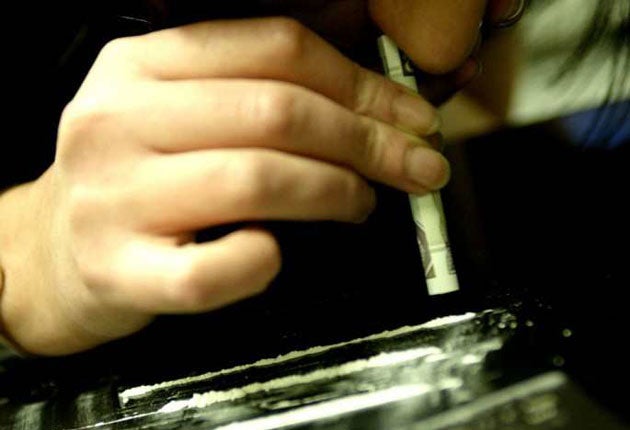Police losing fight to stop cocaine use
Number of people taking drug now tops 800,000, Home Office figures show

Your support helps us to tell the story
From reproductive rights to climate change to Big Tech, The Independent is on the ground when the story is developing. Whether it's investigating the financials of Elon Musk's pro-Trump PAC or producing our latest documentary, 'The A Word', which shines a light on the American women fighting for reproductive rights, we know how important it is to parse out the facts from the messaging.
At such a critical moment in US history, we need reporters on the ground. Your donation allows us to keep sending journalists to speak to both sides of the story.
The Independent is trusted by Americans across the entire political spectrum. And unlike many other quality news outlets, we choose not to lock Americans out of our reporting and analysis with paywalls. We believe quality journalism should be available to everyone, paid for by those who can afford it.
Your support makes all the difference.Britain is losing the war against cocaine with new figures showing a dramatic increase in people using the drug over the past decade and a slump in the volume seized by police.
The proportion of adults using cocaine in the past year has increased nearly four-fold since 1996, to an estimated 810,000 people a year, Home Office figures showed.
Separate figures showed the volume of cocaine seized by police has fallen by more than half since 2003 to 3.2 tonnes last year, despite an increase in the number of seizures.
Overall, drug use has fallen since 2004, led by continuing reductions in the use of cannabis, but the proportion of adults using cocaine in the past year has soared from 0.6 per cent in 1996 to 2.3 per cent in 2007-08.
Ministers are planning a major new public relations offensive targeting cocaine use, with another "Frank" campaign to warn youngsters of the dangers of using the drug.
However, previous campaigns have not been successful. The figures show cocaine use among young people has increased in the past decade with 326,000 16-to-24-year-olds estimated to have taken cocaine in the past year.
Opposition MPs condemned ministers for failing to stem the long term increase in cocaine use, which has remained stubbornly high, amid warnings that street prices of the drug have fallen due to buoyant supply and the increasing use of cut-price adulterated forms of the drug aimed at low-income users.
Dominic Grieve, the shadow Home Secretary, said: "The Government's failure to tackle cocaine is deeply disturbing. Rising cocaine abuse under this government, and the decline in the volume seized by police has virtually halved its street price – storing up problems for a whole generation of young people in our society."
Chris Huhne, the Liberal Democrat home affairs spokesman, described the rise in cocaine use as "startling". He said: "Despite these impressive figures, it is clear that we are only scratching the surface of the drug problem in this country.
Research has shown sharp falls in the street price of cocaine, which has slumped from £70 a gram in 2000 to a current price of about £40 a gram. The Home Office insisted that it was acting to tackle the levels of cocaine abuse. A spokeswoman said: "Compared to 1996, there has been an increase in the use of cocaine among young people and among all adults. However, most of this increase took place in the period to 2000, since when its use has been broadly stable. Tackling cocaine use is integral to the delivery of the Government's drug strategy, and action to tackle its use is embedded within every strand of the strategy."
Explainer: Cocaine
* Cocaine triggers the release of chemicals already present in the body, such as adrenaline, stimulating pleasure-giving neurotransmitters, of which the main one is dopamine.
* Crack cocaine has a more extreme effect, with a sharper high and quicker low.
* Taking crack used to be called chasing the dragon because the drug exhausts your brain of dopamine but people keep using it to try to get another high.
* Smoking either drug can destroy parts of the respiratory system.
* Using them alongside alcohol can place huge stress on the liver because people find they can drink more.
* Light recreational users take cocaine in small amounts and do not use crack.
* Recreational users buy cocaine frequently, typically share it with friends, and occasionally use crack cocaine.
* Binge users buy and take cocaine in large quantities, regularly buy crack cocaine, and plan social occasions around their purchases.
* Most light recreational users graduate to heavier usage: they may claim not to be addicted, but frequently end up dependent on the drug.
Join our commenting forum
Join thought-provoking conversations, follow other Independent readers and see their replies
Comments